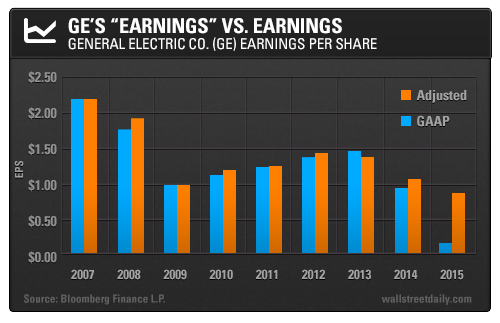On April 22, 2016, General Electric Co. (NYSE:GE) announced first-quarter earnings per share (EPS) of $0.21.
The median Wall Street analyst estimate was somewhat lower, however, at around $0.19.
Thus, the industrial conglomerate had beaten expectations – an observation corroborated by the myriad “earnings beat” news headlines.
Had GE truly exceeded expectations, though?
At the beginning of 2016, the median estimate for the first quarter was up at $0.27. So, GE had, for all intents and purposes, just cleared a lowered hurdle.
Upon even closer examination, the results were downright pathetic.
On a GAAP basis (generally accepted accounting principles), EPS from continuing operations was just $0.02. Making matters worse, net earnings attributable to GE common shareholders was a loss of $98 million.
But GE beat earnings estimates!
The difference between GAAP earnings and pro forma, or adjusted, earnings has garnered more attention recently. Financial statements have to be prepared according to GAAP, but companies are taking increasing liberties with their adjusted figures.
The difference can be quite striking, too.
The chart below shows GE’s GAAP EPS versus its adjusted EPS over the past several years.

As you can see, the two figures were in the same ballpark up until 2014. Then, last year’s GAAP EPS was just $0.16 compared with adjusted EPS of $0.87.
The difference is due, largely, to exit costs associated with shedding parts of GE Capital, the company’s finance arm.
In general, corporate management teams claim that excluding these one-time “extraordinary” items from earnings gives a clearer picture of a company’s true performance.
Furthermore, many analysts contend that lower S&P 500 GAAP earnings are predominantly due to write-downs in the energy sector.
But of course, GE isn’t an energy company. This is an inconvenient fact for those making the “it’s just energy” argument.
Even so, let’s say an energy company made an ill-timed, levered acquisition during the peak of the commodity supercycle, and now has to take an impairment charge. Why should this hit to earnings be excluded? Certainly, if the deal was well-timed and accretive, those incremental profits would not be excluded.
Naturally, if any and all events negatively impacting earnings are ignored, then most companies will show substantial profits. However, extraordinary events are a fact of life.
One-time exclusions are only part of the story, though.
The following chart compares the S&P 500’s standard price-to-earnings (P/E) ratio with its P/E ratio using earnings before extraordinary items.

Both earnings measures actually exclude one-time items.
The yawning difference between the two ratios seems to indicate that companies are becoming increasingly creative in terms of what losses they’re excluding from adjusted earnings. In other words, EPS is higher than it otherwise should be, thus lowering the P/E ratio.
If we use the companies’ earnings figures, the S&P 500 has a P/E of around 19 times.
The real P/E, however, looks to be closer to 24 times.
The Securities and Exchange Commission (SEC) is supposedly going to clamp down on earnings reporting shenanigans. And since the SEC is supposed to ensure that financial reporting is accurate and transparent, it’s a mystery as to why it took so long to address this earnings mirage.
Safe (and high-yield) investing.
